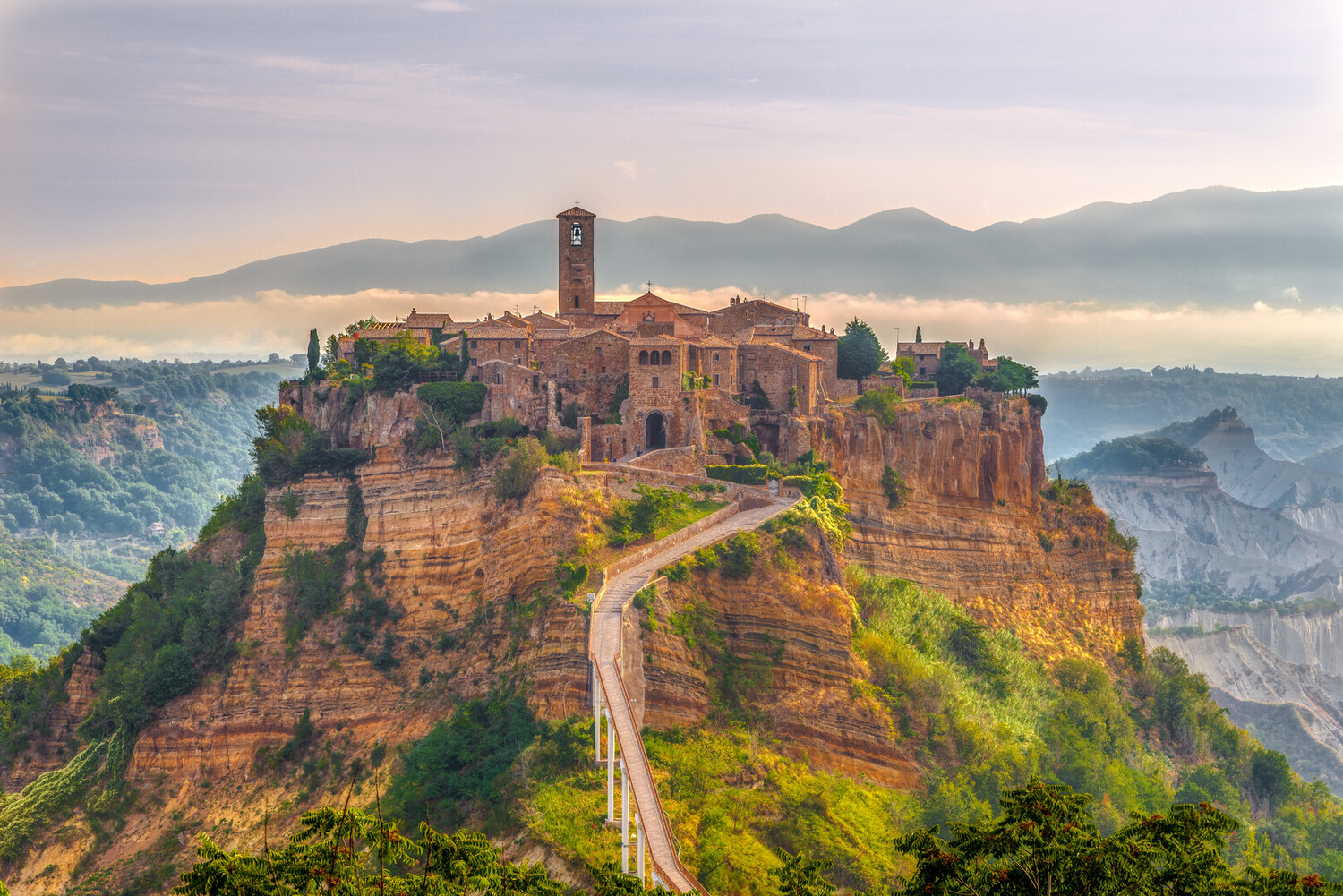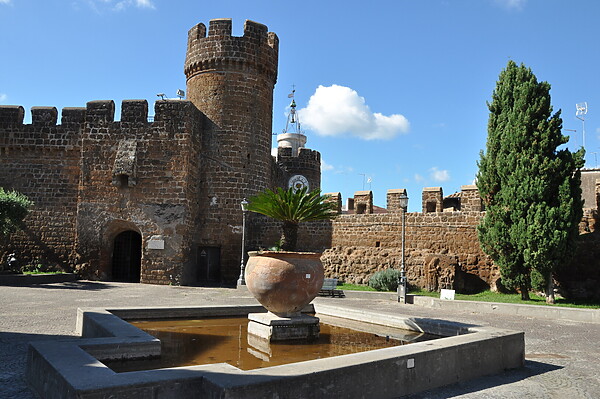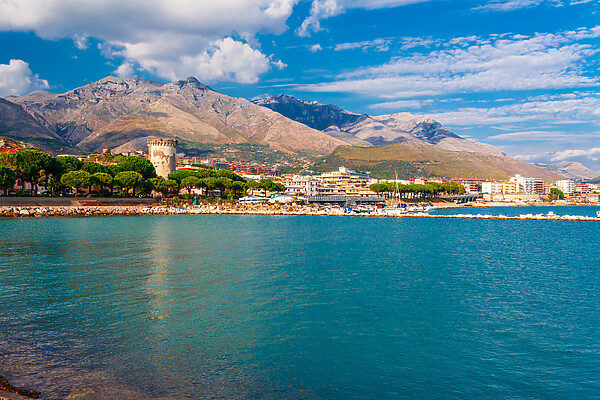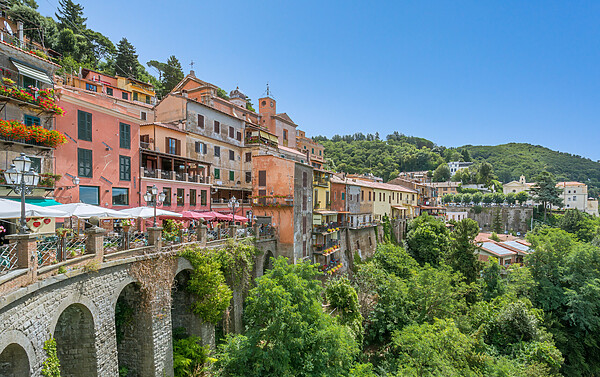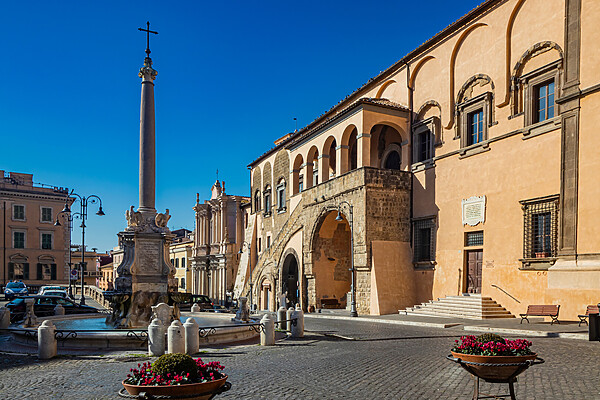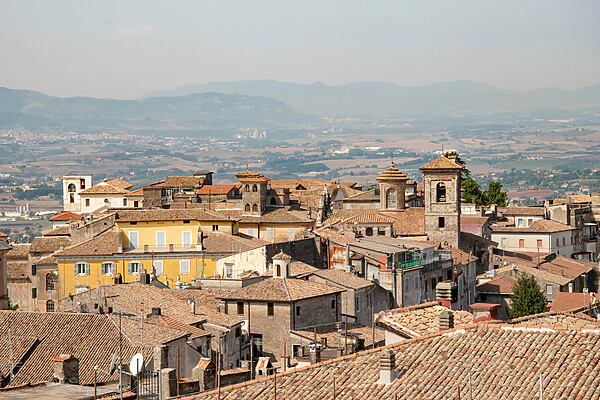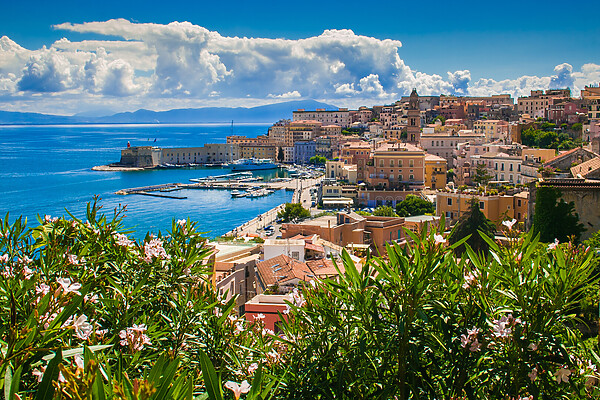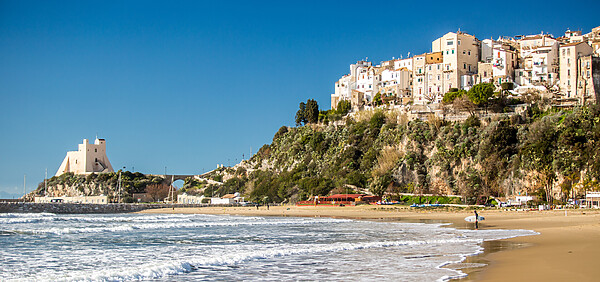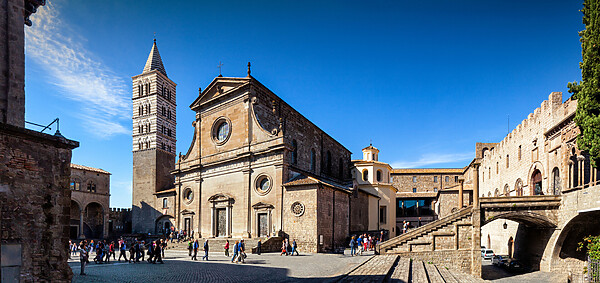Looking for a place that feels like it shouldn’t exist but somehow still does? Welcome to Civita di Bagnoregio, a surreal hilltop village balanced on the edge of a crumbling cliff in northern Lazio. Connected to the rest of the world by a single pedestrian bridge, this “dying town” is anything but lifeless, it’s all cobbled streets, timeless silence, and views you’ll replay in your head long after you’ve left. Add a glass of something local to the mix, thanks to nearby Lazio wine tours, and you’ve got the perfect pairing of slow travel and bold flavors.
Visit Civita di Bagnoregio: The best things to do
Cross the iconic Civita Bridge

The only way to reach Civita di Bagnoregio is on foot, across a long pedestrian bridge that links it to the town of Bagnoregio. It’s a bit of a hike (especially under the summer sun), but the views on the way in are unbeatable. Once you step onto that bridge, it’s like walking out of the present and into another world. Civita greets you with quiet stone lanes, warm terracotta facades, and the feeling that time here simply stopped.
Visit the Church of San Donato in the main piazza
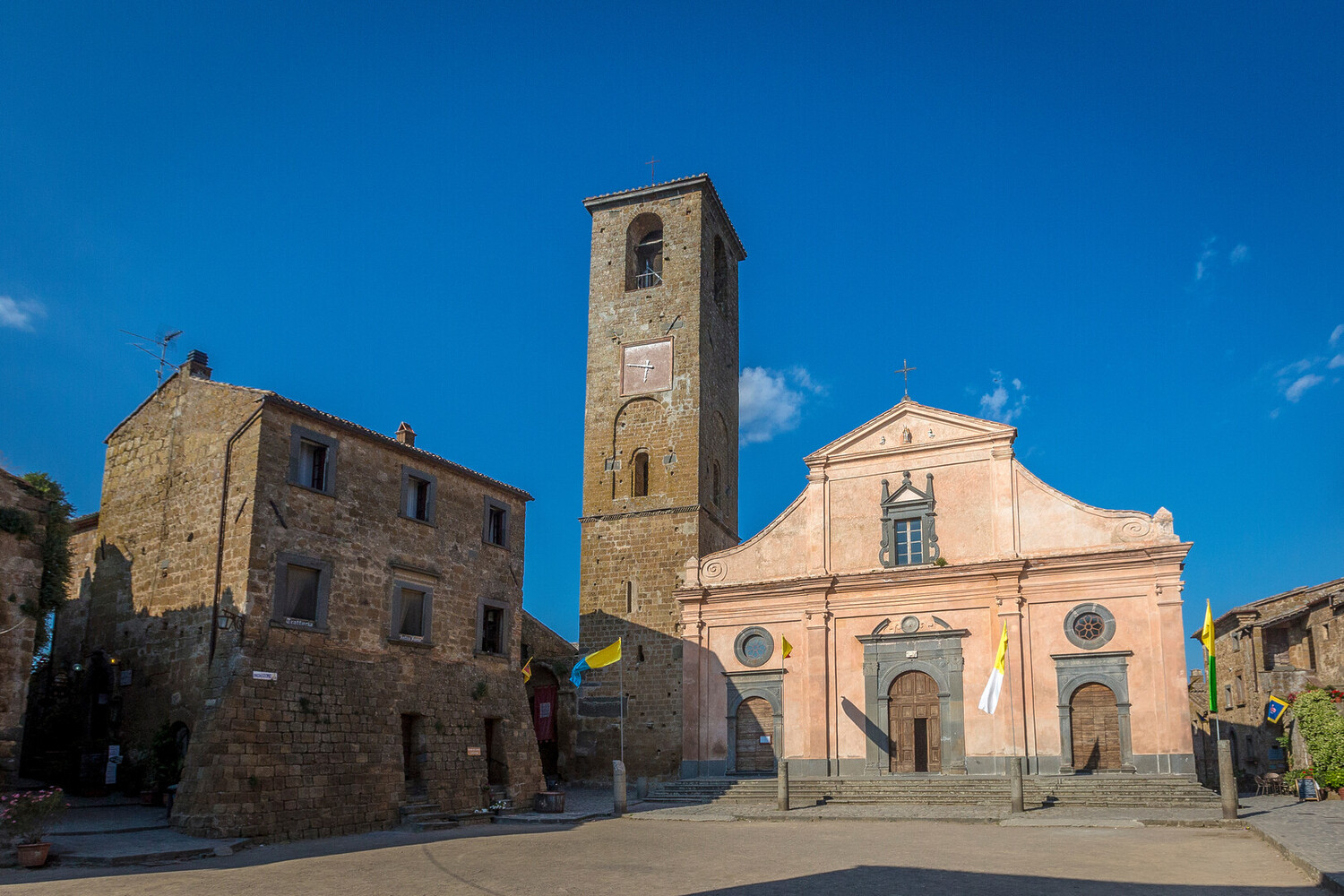
Right in the heart of Civita di Bagnoregio, the Church of San Donato anchors the main piazza with quiet elegance. This Romanesque gem dates back to the 7th century and holds a cherished 15th-century crucifix that’s deeply meaningful to the locals. The square in front of it isn’t just for admiring architecture, it also hosts the quirky and beloved Palio della Tonna, a traditional donkey race held twice a year.
Explore the eerie charm of the alleyways
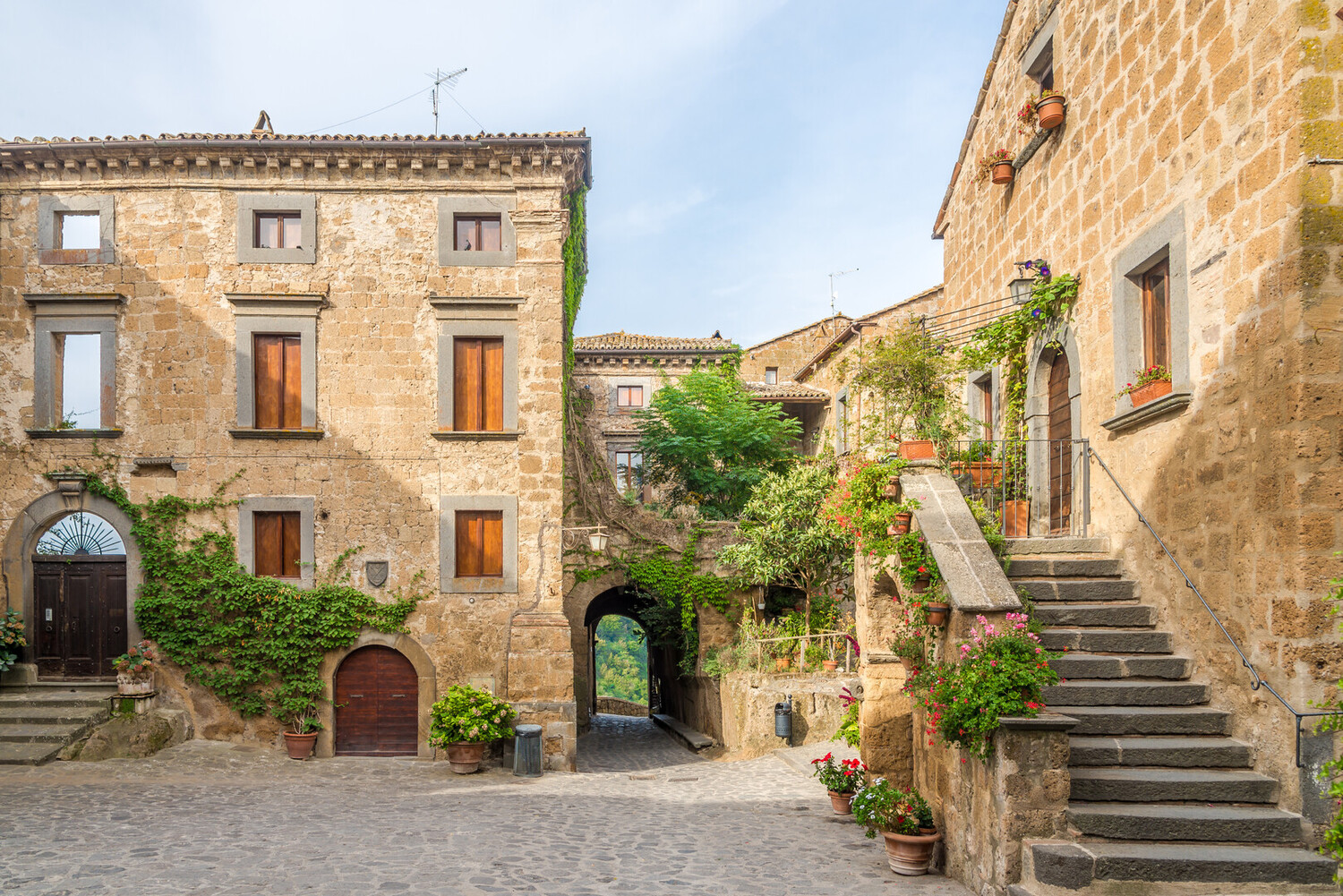
Get lost, in the best way, in Civita’s maze of cobbled lanes, ivy-draped walls, and flower-filled balconies. This place feels like it was plucked straight out of a storybook (Rick Steves even called it one of Italy’s hidden gems, and we’re not arguing). Want to turn up the charm even more? Time your visit for winter and catch the magical living nativity scene. Locals in costume, candlelit streets, and that cozy medieval glow, yep, it’s every bit as magical as it sounds.
Pay homage to Bonaventura

Civita di Bagnoregio isn’t just about views, it’s also the birthplace of Saint Bonaventure, one of the great minds of the 13th century. A small shrine and stone archway honor his legacy in the village where he grew up. Legend has it that as a sick child, he was miraculously healed by Saint Francis of Assisi right here in Civita. Later, Bonaventure became a major figure in the Franciscan order and left his mark on religious thought. It’s a pretty inspiring story, and one more reason this tiny town packs a historical punch.
Visit Civita di Bagnoregio: Best things to do around
Wander the Valle dei Calanchi for unforgettable photos
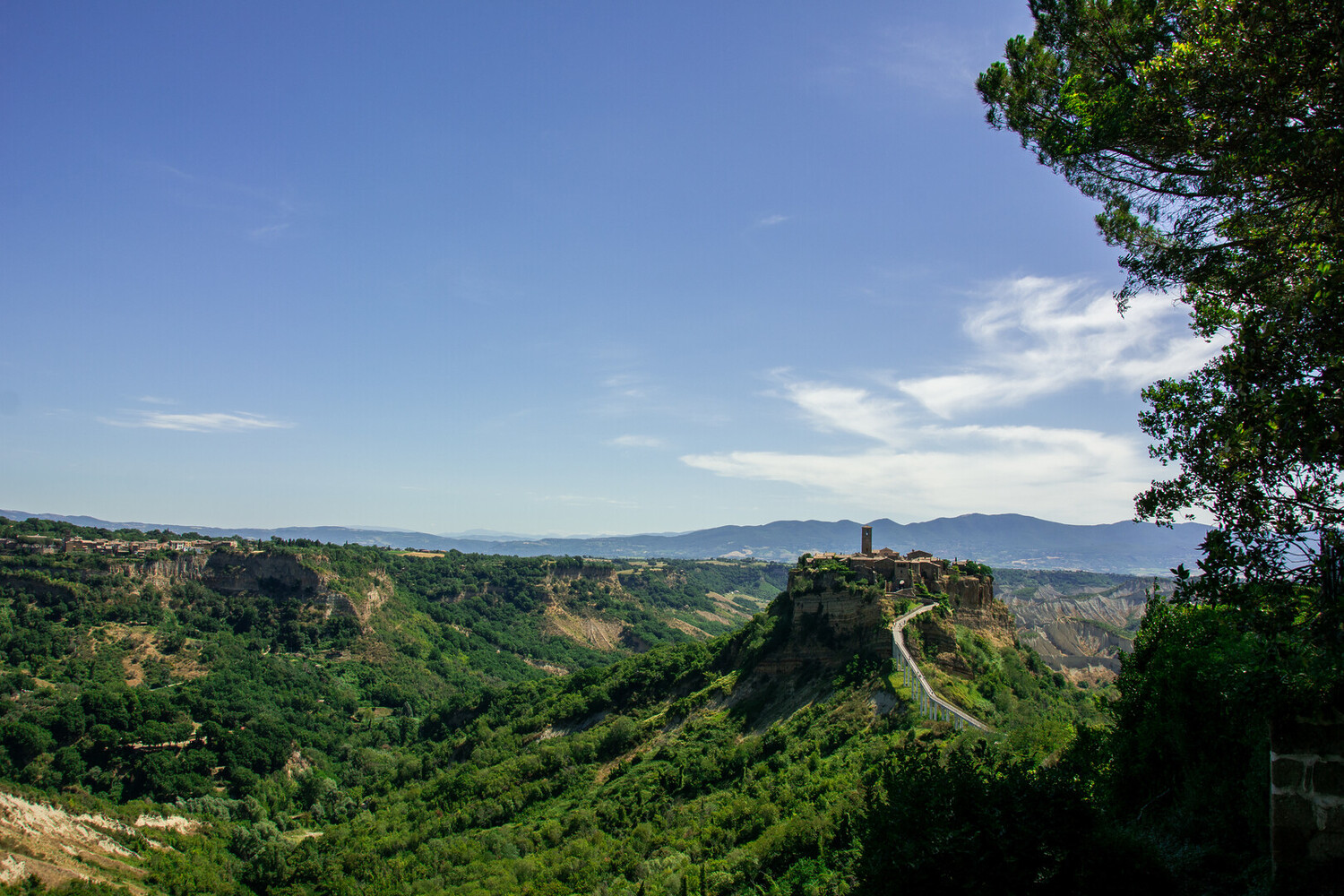
Don’t leave Civita without gazing out over the Valle dei Calanchi. This surreal landscape of crumbling clay ridges and deep gullies feels like another planet, and it’s the reason Civita is called la città che muore (“the dying city”). The contrast between the wild green hills and the jagged tufa cliffs makes for unforgettable views and the kind of photo you’ll want to frame. It’s not just a beautiful panorama, it’s a reminder of how nature shapes everything, even an ancient town like this one.
Explore Orvieto’s underground wonders
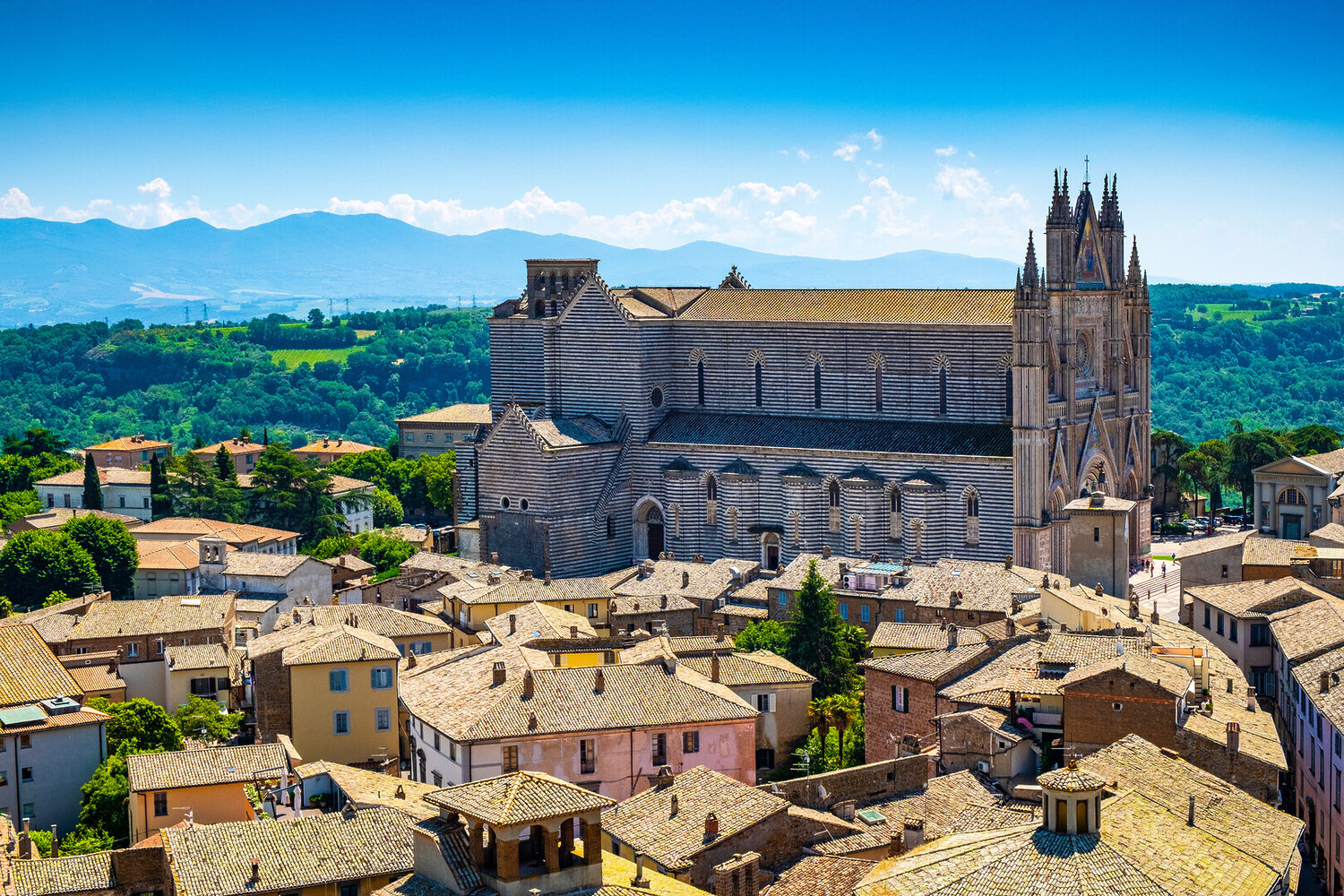
33 minutes from Civita di Bagnoregio, Orvieto is one of those hill towns that instantly impress. Set high on a tufa cliff, it’s packed with Etruscan roots, cobbled streets, and postcard-worthy views of the Umbrian countryside. The Orvieto Cathedral is a must, its striped façade and golden mosaics are a jaw-dropper, and beneath the town lies a maze of ancient tunnels carved thousands of years ago. Wine lovers, take note: this is the home of Orvieto Classico, one of Italy’s most celebrated white wines. Pop into a local winery or enjoy a glass with lunch on a sunny terrace.
Wander through Viterbo’s streets
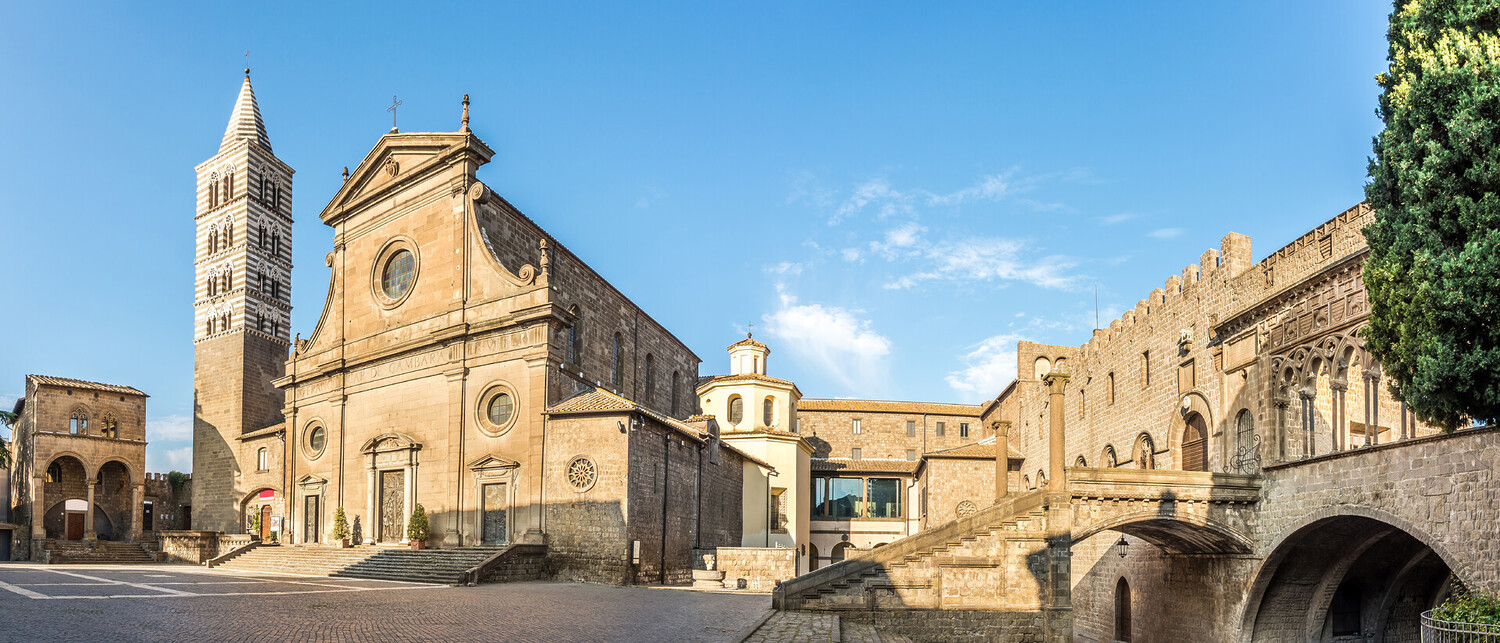
About 35 minutes from Civita di Bagnoregio, Viterbo is the kind of town that feels like a living museum, with cobbled lanes, medieval towers, and the grand Palazzo dei Papi at its center. But it’s not all stone and history. Viterbo is also famous for its thermal springs, especially the Terme dei Papi, where you can soak in warm, mineral-rich waters surrounded by nature. After walking the long bridge to Civita and exploring its narrow alleys, there’s nothing better than slipping into a steaming outdoor pool to relax like royalty.
Visit Viterbo Italy and uncover the best activities in town to complete your adventure!
Visit Montefiascone on the hills
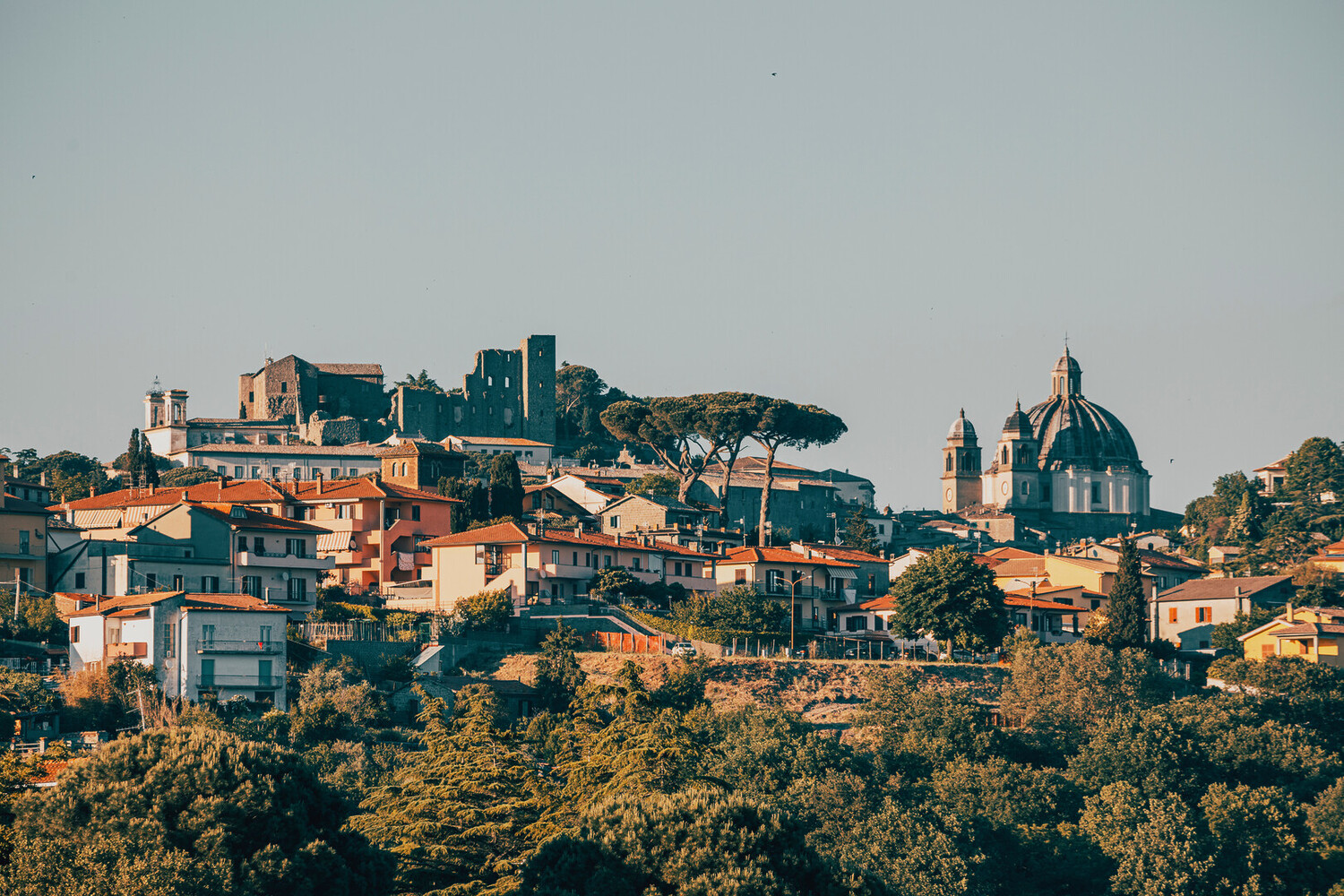
Perched above Lake Bolsena and just a short drive from Civita di Bagnoregio, Montefiascone is the perfect mix of history and wine. This hilltop town is part of the ancient Via Francigena pilgrim route and home to the Rocca dei Papi, a fortress that once hosted popes on summer retreat. But the real star here is Est! Est!! Est!!!, a local white wine with a legendary name and a smooth, easy-drinking style. Stop by a local vineyard for a tasting, nibble on cheese and bread, and pick up a bottle to remember your trip. It’s a laid-back stop with big views and even bigger flavor.
Discover the wine trails of Lazio
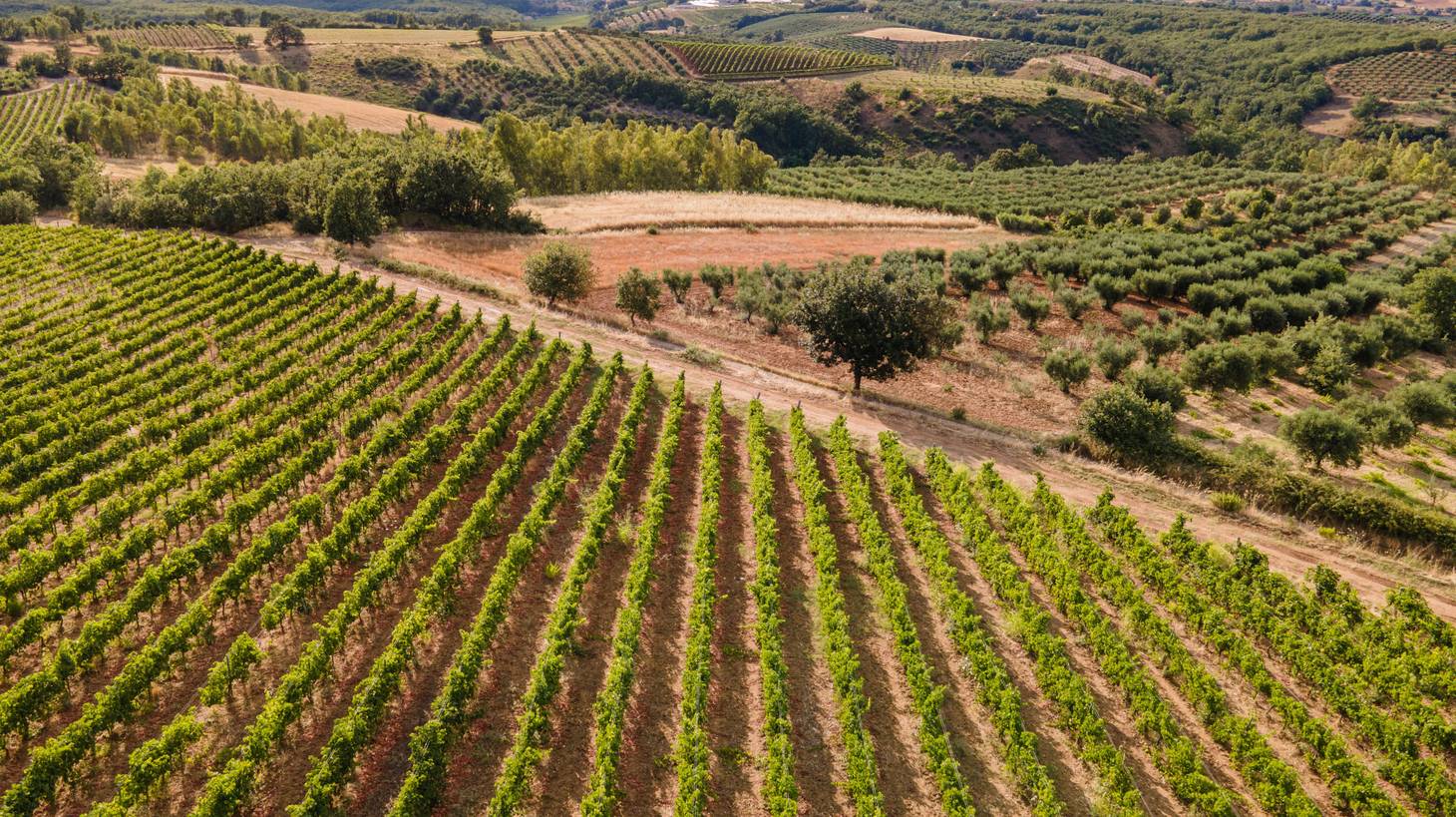
If you’ve fallen for the charm of Frascati or sipped your way through the vineyards near Cerveteri, why not keep exploring Lazio’s rich wine scene? Head toward the rolling hills around Piglio or Anagni, where Cantina Sociale Cesanese del Piglio offers an authentic taste of central Italy. Here, native grapes like Cesanese thrive on volcanic soil, producing bold reds that pair perfectly with local cheeses and cured meats. Between the vineyard views and the warm, family-run tastings, it’s an easygoing way to experience Lazio’s wine heritage, one glass at a time.
Good to know before visiting Civita di Bagnoregio
Is Civita di Bagnoregio worth visiting?
Absolutely! Civita di Bagnoregio is one of Italy’s most enchanting hilltop towns, often referred to as “La città che muore” (The Dying City) due to its ongoing erosion. With its dramatic location atop a fragile volcanic plateau, medieval stone houses, cobblestone streets, and lack of cars, Civita offers a rare and peaceful glimpse into Italy’s past. Whether you’re passionate about architecture, photography, or just want to experience authentic Italian charm, Civita is well worth a visit.
How do you visit Civita di Bagnoregio?
Civita di Bagnoregio is accessible on foot via a pedestrian bridge from the town of Bagnoregio. To get there, most visitors drive or take public transport to Bagnoregio, which is located about 1.5 hours north of Rome. From the parking area in Bagnoregio, it is about a 20-minute walk up a gradually inclined bridge to reach the gates of Civita. The bridge can be steep, so comfortable shoes are recommended. Note that there is a small entrance fee to access Civita, usually collected at the start of the footbridge.
How long is the footbridge to Civita di Bagnoregio?
The pedestrian bridge connecting Civita to Bagnoregio is approximately 300 meters (about 985 feet) long. It rises steeply towards the town, offering spectacular views of the surrounding valley, known as the “Valley of the Badlands” (Valle dei Calanchi). The walk can be physically challenging for some visitors, especially in hot weather, so bringing water and taking breaks on the way up is advisable.
What are the best hotels in Civita di Bagnoregio?
While accommodations in Civita itself are limited due to its small size, there are charming options both within the village and nearby Bagnoregio:
- B&B Vatra: Located inside the town walls, offering rustic charm and exceptional hospitality.
- Hotel Romantica Pucci: Situated in Bagnoregio, this hotel offers cozy rooms just a short walk from the entrance to the footbridge.
- La Loggetta Bed and Breakfast: Located near the footbridge, this B&B offers warm service and superb local breakfast.
What are the best restaurants in Civita di Bagnoregio?
- Alma Civita: A refined restaurant built into ancient caves offering regional delicacies such as wild boar ragu and truffle-infused dishes.
- Antico Forno: A cozy trattoria serving homemade pasta, bruschette, and local meats — ideal for a hearty lunch post-walk.
- La Cantina di Arianna: A family-run spot with fantastic views and a menu full of local produce and Umbrian wines.
- Trattoria del Moro Aronne: Just outside Civita in Bagnoregio, this traditional eatery is known for hand-cut pasta and homemade desserts.
Can you drive to Civita di Bagnoregio?
No, Civita is not accessible by car. It is a pedestrian-only village to preserve its historic character and delicate infrastructure. Visitors must park in Bagnoregio and walk across the footbridge to enter Civita. Designated parking areas with shuttle services are available in Bagnoregio during peak seasons.
When is the best time of year to visit Civitadi Bagnoregio?
The best times to visit Civita di Bagnoregio are spring (April to June) and early autumn (September to October). These months offer pleasant weather, fewer crowds, and vibrant scenery. Summer can be hot and crowded, especially on weekends, while winter offers fewer tourists but limited services and shorter daylight.
How much time do you need in Civita di Bagnoregio?
Most visitors find that 2–4 hours is sufficient to explore Civita di Bagnoregio. This allows for a leisurely walk across the bridge, strolling through the town, visiting the Church of San Donato, enjoying a meal, and capturing plenty of scenic photos. If you want to experience a magical overnight stay or explore the surrounding countryside, consider spending at least one night.


